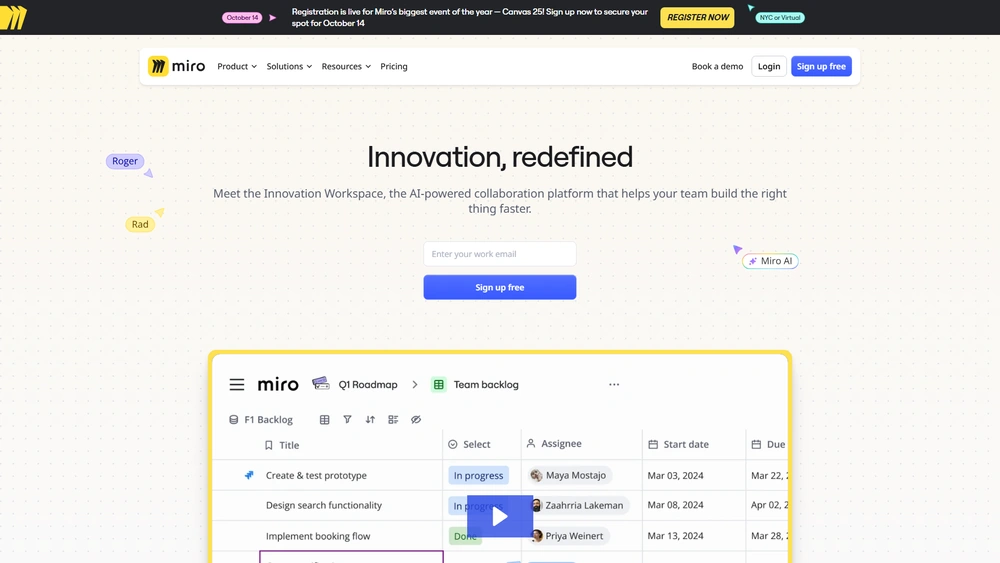Miro Overview & 2025 Industry Position
Miro is a leading digital whiteboard and visual collaboration platform designed to help teams ideate, plan, and execute together in real time—regardless of location. In 2025, Miro’s platform serves over 60 million users globally, cementing its role as a cornerstone tool for hybrid and remote-first enterprises. With generative AI, productized workflows, and powerful integrations, Miro is now not only a canvas for brainstorming but an execution engine for complex projects. In an era defined by team velocity and asynchronous communication, Miro empowers cross-functional innovation like never before.
From Launch to 2025: Miro’s Journey
Miro began as RealtimeBoard in 2011, founded by Andrey Khusid and Oleg Shardin in Perm, Russia. Originally conceived as an online whiteboard, it quickly attracted remote tech teams. In 2019, it rebranded to Miro, reflecting its broader collaborative mission. Since then, notable milestones have included:
- 2019: Rebrands to Miro; reaches 3M+ users
- 2021: Raises $400M in Series C; hits 20M users
- 2022: Launches Miroverse, a community template library
- 2023: Introduces Miro AI and interactive presentation mode
- 2024: Surpasses 50M users with expanded enterprise features
- 2025: Focuses on industry-specific solutions and seamless integrations
The 2025 thesis: Miro is evolving from a visual collaboration tool to a strategic ecosystem for ideation, workflow execution, and organizational alignment.

Miro Key Features
Miro’s feature set continues to expand and deepen its collaborative core. Key capabilities include:
- Smart Canvas: Infinite whiteboard with sticky notes, diagrams, and embedded media
- Miro AI: Generates mind maps, summarizes boards, and drafts strategy insights
- Templates & Miroverse: 1,000+ prebuilt templates from global teams and consultants
- Presentation Mode: Turns boards into interactive walkthroughs for stakeholders
- Facilitation Tools: Voting, timers, frames, and breakouts for real-time workshops
- Access Control: Role-based permissions, domain control, and SSO for enterprises
- Embedded Apps: Jira, Asana, Figma, Zoom, Google Workspace, and more
Workflow & UX
Miro delivers a user-centric experience that supports both spontaneous ideation and structured collaboration. The UI is intuitive, with rapid contextual menus and right-click actions across content blocks. Navigation remains fluid around expansive boards, with zoom tools, minimap, and panning accelerators. New users can start with templates while experts dive into automation flows and API connections. Miro is equally supportive of spontaneous brainstorms and methodical planning.
Miro Pricing Analysis & Value Metrics
Miro’s pricing model supports individuals, teams, and large organizations with scalable tiers. Accurate as of July 2025:
| Plan | Monthly Price (Billed Annually) | Key Inclusions |
|---|---|---|
| Free | $0 | 3 boards, basic templates, limited collaboration tools |
| Starter | $10/user | Unlimited boards, private sharing, integrations |
| Business | $20/user | Advanced controls, Miro AI, team workspaces |
| Enterprise | Custom | SSO, SCIM, enterprise-grade security, analytics |
Value Assessment: For teams beyond 3 collaborators, Miro Starter offers excellent ROI—especially when compared to piecing together disparate tools.
Competitive Landscape
Miro faces stiff competition in both generalized whiteboarding and niche SaaS verticals. A quick breakdown as of 2025:
| Tool | Main Edge | Ideal Users |
|---|---|---|
| FigJam | Design-integrated workflows (Figma) | UX designers and creative agencies |
| LucidSpark | Lucidchart diagramming synergy | Enterprise process ops teams |
| Jamboard (legacy) | Native Google education syncing | K–12 educators |
| Notion Canvas | Embedded docs with visual canvases | Product teams already using Notion |
Miro Business stands out for hybrid enterprises seeking deep participation and workflow customization.
Use Cases
Where Miro shines:
- Product Discovery: Empathy maps, Kano models, and prioritization matrices
- Agile Ceremonies: Retrospectives, sprint planning, and PI board planning
- Strategic Planning: Goal alignment, OKRs, initiative tracking
- Workshops & Training: L&D sessions, design thinking, stakeholder presentations
Miro adapts to startups, creative agencies, enterprise PMOs, and education hubs alike.
Integrations & Ecosystem
Miro supports 120+ integrations, streamlining workflows and syncing real-time data across tools. Popular connections:
- Productivity: Jira, Confluence, Asana, Trello
- Design: Figma, Adobe XD, Sketch
- Communication: Zoom, Slack, Microsoft Teams
- Docs/Spreadsheets: Google Drive, Notion, Excel
- Single Sign-On: Okta, Azure AD, Google SSO
The Miro Developer Platform also allows custom apps and webhook syncs for proprietary systems.
Pros & Cons
- Pros:
- Flexible, visual collaboration suited for all teams
- Integrated AI improves speed and creative breakout
- Scalable from free hobby use to enterprise SSO deployments
- Extensive template and integration library
- Cons:
- Learning curve for non-technical or analog users
- Business plans can be pricey for small orgs
- Performance on large boards can slow browser/rendering
Pro Tip: Create a “Team Hub” template in Miro that you duplicate for each project—capturing backlog, ownership, and roadmaps in one visual space.
Final Thoughts
Miro continues to lead the visual collaboration segment with advanced tools for ideation and execution. It’s ideal for cross-functional teams needing real-time sync and asynchronous continuity. Though budgets may rise for premium features, the strategic value delivered is unmatched in design, PM, ops, and innovation workflows.
Miro Q & A
Yes, Miro’s Free and Starter plans are popular among freelancers and solopreneurs wanting a visual planning space.
Yes. Boards can be exported as PDFs, images, or embedded links, depending on plan level.
Miro is primarily cloud-based, but offline access for viewing is available in certain enterprise deployments.
Miro includes enterprise-grade encryption, ISO 27001 compliance, and SAML/SSO features for secure deployments.
Start with interactive templates, provide initial training via presentation mode, and enable Miro AI to generate workflows quickly.